沃尔玛全球风险管理.ppt
- 格式:ppt
- 大小:455.52 KB
- 文档页数:29

危机管理以及沃尔玛全球风险管理在当今全球化的商业环境中,企业面临各种来自内外部的风险与危机。
有效的危机管理和风险管理是企业成功的重要因素之一。
本文将探讨危机管理的重要性以及沃尔玛全球风险管理的案例。
1. 危机管理的重要性危机是指在某一特定时刻发生的事态,可能对企业的声誉、经营和利益产生严重的影响。
危机管理的目标是通过实施预防措施、紧急处理和恢复计划,减少危机对企业的影响。
以下是危机管理的几个重要方面:1.1 风险评估和预防危机管理的第一步是评估潜在风险并采取预防措施。
企业应该对可能发生的风险进行全面的评估,包括市场风险、供应链风险、技术风险等等。
通过定期的风险评估,企业可以制定相应的预防计划,减少潜在的危机风险。
1.2 危机传播和沟通在危机发生时,有效的传播和沟通是至关重要的。
企业应该制定紧急情况下的沟通计划,并确保及时、准确地向内外部利益相关者提供信息。
透明和负责任的沟通有助于建立信任和控制危机的舆论。
1.3 快速反应和危机管理团队企业应该建立一个专门的危机管理团队,负责风险评估、预警和紧急处理。
这个团队应该具备快速反应和决策的能力,能够迅速制定和执行应对策略,以最大程度地减少危机对企业的损害。
2. 沃尔玛全球风险管理的案例作为全球最大的零售商之一,沃尔玛面临着多样化的风险和挑战。
为了有效管理这些风险,沃尔玛建立了全球风险管理体系,涵盖了其在全球范围内的所有业务。
2.1 风险评估和预防沃尔玛通过定期的风险评估来确定可能的风险,并采取相应的预防措施。
例如,在供应链领域,沃尔玛采用先进的供应链技术和实时数据分析,以确保产品的品质和安全性。
此外,沃尔玛还与供应商建立了紧密的合作关系,确保其供应链的可靠性。
2.2 危机传播和沟通沃尔玛注重危机传播和沟通,在危机发生时能够及时向内外部相关方提供准确的信息。
例如,在食品安全问题上,沃尔玛建立了紧急响应团队,并制定了详细的沟通计划。
这使得沃尔玛能够在食品安全问题发生时快速采取行动,并向公众透明地传达相关信息。


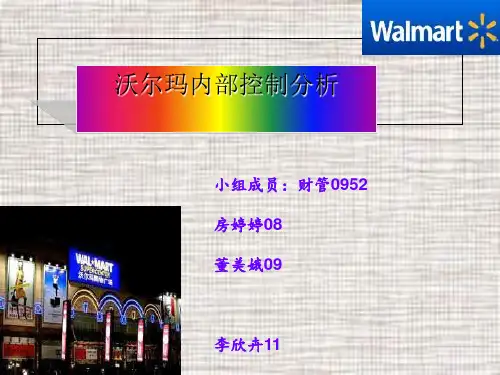

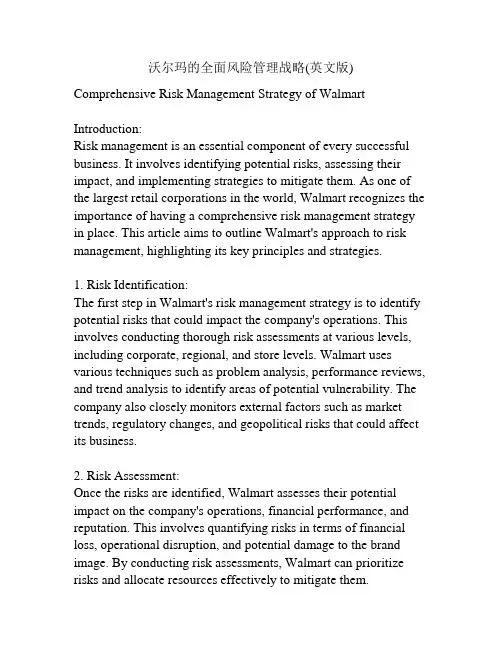
沃尔玛的全面风险管理战略(英文版) Comprehensive Risk Management Strategy of Walmart Introduction:Risk management is an essential component of every successful business. It involves identifying potential risks, assessing their impact, and implementing strategies to mitigate them. As one of the largest retail corporations in the world, Walmart recognizes the importance of having a comprehensive risk management strategy in place. This article aims to outline Walmart's approach to risk management, highlighting its key principles and strategies.1. Risk Identification:The first step in Walmart's risk management strategy is to identify potential risks that could impact the company's operations. This involves conducting thorough risk assessments at various levels, including corporate, regional, and store levels. Walmart uses various techniques such as problem analysis, performance reviews, and trend analysis to identify areas of potential vulnerability. The company also closely monitors external factors such as market trends, regulatory changes, and geopolitical risks that could affect its business.2. Risk Assessment:Once the risks are identified, Walmart assesses their potential impact on the company's operations, financial performance, and reputation. This involves quantifying risks in terms of financial loss, operational disruption, and potential damage to the brand image. By conducting risk assessments, Walmart can prioritize risks and allocate resources effectively to mitigate them.3. Risk Mitigation Strategies:After assessing the risks, Walmart implements strategies to mitigate them and minimize their impact on the company. This includes developing and implementing robust internal controls, standard operating procedures, and policies to prevent and detect risks. Walmart also invests in state-of-the-art technology and infrastructure to ensure the security and efficiency of its operations. For example, the company uses advanced surveillance systems and cybersecurity measures to protect its stores and customer data from potential threats.Walmart also believes in fostering a culture of risk management throughout the organization. It educates and trains its employees on risk awareness and encourages them to report any potential risks or violations. This helps Walmart to proactively address risks and prevent potential issues before they escalate.4. Crisis Management:Despite careful planning and risk mitigation efforts, unexpected events can still occur. Walmart understands the importance of having a robust crisis management plan in place. The company has a dedicated crisis management team that is responsible for coordinating responses to various crises, such as natural disasters, product recalls, or public relations crises. Walmart's crisis management plan outlines clear procedures for communication, decision-making, and business continuity to ensure a swift and effective response to any crisis situation.5. Business Continuity Planning:Another critical aspect of Walmart's risk management strategy is business continuity planning. This involves developing strategies and procedures to ensure the continuous operation of key business functions in the event of a disruption. Walmart has comprehensive business continuity plans at both the corporate and individual store levels. These plans outline alternative operating procedures, backup systems, and recovery strategies to minimize downtime and mitigate the impact of any disruption.6. Continuous Improvement:Walmart recognizes that risk management is an ongoing process that requires continuous improvement and adaptation. The company regularly reviews and updates its risk management strategies to address emerging risks and changing business environments. It actively seeks feedback from employees, customers, and stakeholders to identify areas for improvement and implement necessary changes.Conclusion:Walmart's comprehensive risk management strategy demonstrates its commitment to ensuring the safety, security, and continuity of its operations. By adopting a proactive and holistic approach torisk management, Walmart can identify and mitigate potential risks, minimize their impact, and maintain its position as one of the world's leading retail corporations.Certainly! Here are some additional points to expand on Walmart's risk management strategy: 1. Supply Chain Risk Management:Walmart's risk management strategy includes a strong focus on supply chain management. The company recognizes thatdisruptions in its supply chain can have a significant impact on its operations and ability to serve customers. To mitigate supply chain risks, Walmart has implemented several strategies. Firstly, the company has diversified its supplier base to reduce dependency on a single supplier or region. This helps to minimize the impact of any potential disruptions, such as natural disasters or geopolitical issues. Secondly, Walmart closely collaborates with its suppliers to ensure they meet specific quality, safety, and compliance standards. The company also conducts regular audits and inspections to mitigate the risks associated with unethical practices or non-compliance.2. International Risk Management:As a global retail corporation, Walmart operates in various countries with different regulatory, political, and cultural environments. To manage the risks associated with international operations, Walmart has established a robust governance structure. The company has a dedicated international risk management team that monitors and assesses risks specific to each country. This allows Walmart to tailor its risk mitigation strategies to address the unique challenges and requirements of individual markets. Additionally, Walmart maintains strong relationships with local stakeholders, government agencies, and industry associations to proactively address any potential risks or issues that may arise.3. Data Privacy and Cybersecurity:The increasing reliance on technology and digital systems within the retail industry brings new risks such as data breaches and cyber-attacks. Walmart recognizes the importance of protecting customer and company data from potential threats. The companyhas invested heavily in cybersecurity measures, including firewalls, encryption, and constant monitoring of its systems. Walmart also regularly conducts vulnerability assessments and penetration tests to identify and address any potential weaknesses. In addition to technical safeguards, Walmart has implemented strict data privacy policies and procedures to ensure compliance with relevant regulations and protect customer privacy.4. Regulatory Compliance:Operating in a highly regulated industry, Walmart places a strong emphasis on compliance with applicable laws and regulations. The company has a dedicated legal and compliance team that monitors and ensures adherence to local, national, and international regulations. Walmart invests in training programs for its employees to ensure they are aware of and comply with relevant laws and regulations. The company also conducts regular internal audits to assess compliance and identify areas for improvement. Walmart's commitment to regulatory compliance helps to mitigate the risks associated with legal sanctions, reputational damage, and operational disruptions.5. Environmental Sustainability:Walmart recognizes the risks associated with climate change and environmental degradation and has integrated sustainable practices into its risk management strategy. The company has set ambitious goals to reduce greenhouse gas emissions, promote renewable energy, minimize waste, and conserve natural resources. By adopting sustainable business practices, Walmart reduces its exposure to potential regulatory, reputational, and operational risks. The company also works closely with its suppliers to promotesustainable sourcing and production practices throughout its supply chain.Conclusion:Walmart's comprehensive risk management strategy encompasses a wide range of areas, including risk identification, assessment, mitigation, crisis management, business continuity planning, and continuous improvement. Through its proactive and holistic approach, Walmart can effectively manage potential risks and ensure the safety, security, and continuity of its operations. By placing a strong emphasis on supply chain integrity, international risk management, data privacy, regulatory compliance, and environmental sustainability, Walmart demonstrates its commitment to long-term success and resilience in an ever-changing business landscape.。
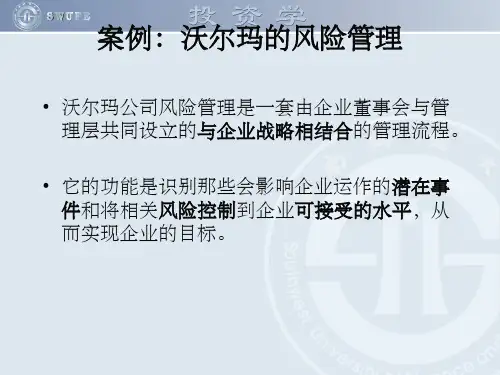
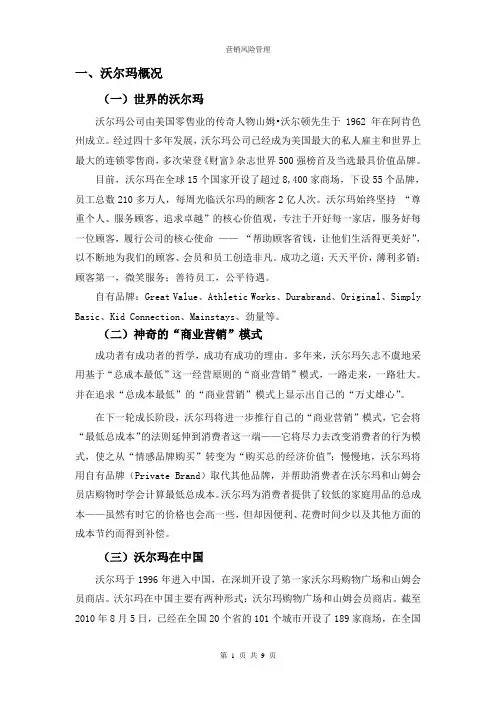
一、沃尔玛概况(一)世界的沃尔玛沃尔玛公司由美国零售业的传奇人物山姆•沃尔顿先生于1962年在阿肯色州成立。
经过四十多年发展,沃尔玛公司已经成为美国最大的私人雇主和世界上最大的连锁零售商,多次荣登《财富》杂志世界500强榜首及当选最具价值品牌。
目前,沃尔玛在全球15个国家开设了超过8,400家商场,下设55个品牌,员工总数210多万人,每周光临沃尔玛的顾客2亿人次。
沃尔玛始终坚持“尊重个人、服务顾客、追求卓越”的核心价值观,专注于开好每一家店,服务好每一位顾客,履行公司的核心使命——“帮助顾客省钱,让他们生活得更美好”,以不断地为我们的顾客、会员和员工创造非凡。
成功之道:天天平价,薄利多销;顾客第一,微笑服务;善待员工,公平待遇。
自有品牌:Great Value、Athletic Works、Durabrand、Original、Simply Basic、Kid Connection、Mainstays、劲量等。
(二)神奇的“商业营销”模式成功者有成功者的哲学,成功有成功的理由。
多年来,沃尔玛矢志不虞地采用基于“总成本最低”这一经营原则的“商业营销”模式,一路走来,一路壮大。
并在追求“总成本最低”的“商业营销”模式上显示出自己的“万丈雄心”。
在下一轮成长阶段,沃尔玛将进一步推行自己的“商业营销”模式,它会将“最低总成本”的法则延伸到消费者这一端——它将尽力去改变消费者的行为模式,使之从“情感品牌购买”转变为“购买总的经济价值”;慢慢地,沃尔玛将用自有品牌(Private Brand)取代其他品牌,并帮助消费者在沃尔玛和山姆会员店购物时学会计算最低总成本。
沃尔玛为消费者提供了较低的家庭用品的总成本——虽然有时它的价格也会高一些,但却因便利、花费时间少以及其他方面的成本节约而得到补偿。
(三)沃尔玛在中国沃尔玛于1996年进入中国,在深圳开设了第一家沃尔玛购物广场和山姆会员商店。
沃尔玛在中国主要有两种形式:沃尔玛购物广场和山姆会员商店。
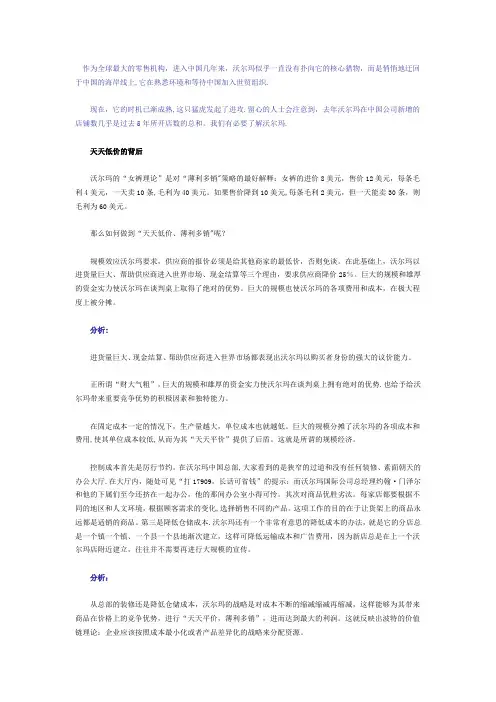
作为全球最大的零售机构,进入中国几年来,沃尔玛似乎一直没有扑向它的核心猎物,而是悄悄地迂回于中国的海岸线上,它在熟悉环境和等待中国加入世贸组织.现在,它的时机已渐成熟,这只猛虎发起了进攻.留心的人士会注意到,去年沃尔玛在中国公司新增的店铺数几乎是过去5年所开店数的总和。
我们有必要了解沃尔玛.天天低价的背后沃尔玛的“女裤理论”是对“薄利多销"策略的最好解释:女裤的进价8美元,售价12美元,每条毛利4美元,一天卖10条,毛利为40美元。
如果售价降到10美元,每条毛利2美元,但一天能卖30条,则毛利为60美元。
那么如何做到“天天低价、薄利多销"呢?规模效应沃尔玛要求,供应商的报价必须是给其他商家的最低价,否则免谈。
在此基础上,沃尔玛以进货量巨大、帮助供应商进入世界市场、现金结算等三个理由,要求供应商降价25%。
巨大的规模和雄厚的资金实力使沃尔玛在谈判桌上取得了绝对的优势。
巨大的规模也使沃尔玛的各项费用和成本,在极大程度上被分摊。
分析:进货量巨大、现金结算、帮助供应商进入世界市场都表现出沃尔玛以购买者身份的强大的议价能力。
正所谓“财大气粗”,巨大的规模和雄厚的资金实力使沃尔玛在谈判桌上拥有绝对的优势.也给予给沃尔玛带来重要竞争优势的积极因素和独特能力。
在固定成本一定的情况下,生产量越大,单位成本也就越低。
巨大的规模分摊了沃尔玛的各项成本和费用,使其单位成本较低,从而为其“天天平价”提供了后盾。
这就是所谓的规模经济。
控制成本首先是厉行节约。
在沃尔玛中国总部,大家看到的是狭窄的过道和没有任何装修、素面朝天的办公大厅.在大厅内,随处可见“打17909,长话可省钱”的提示;而沃尔玛国际公司总经理约翰·门泽尔和他的下属们至今还挤在一起办公,他的那间办公室小得可怜。
其次对商品优胜劣汰。
每家店都要根据不同的地区和人文环境,根据顾客需求的变化,选择销售不同的产品。
这项工作的目的在于让货架上的商品永远都是适销的商品。
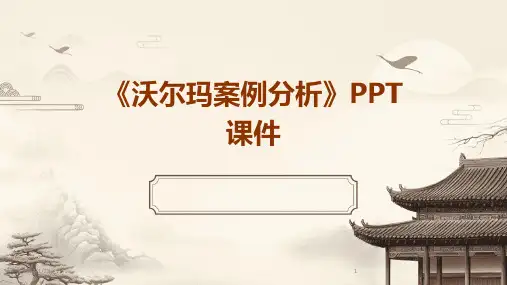
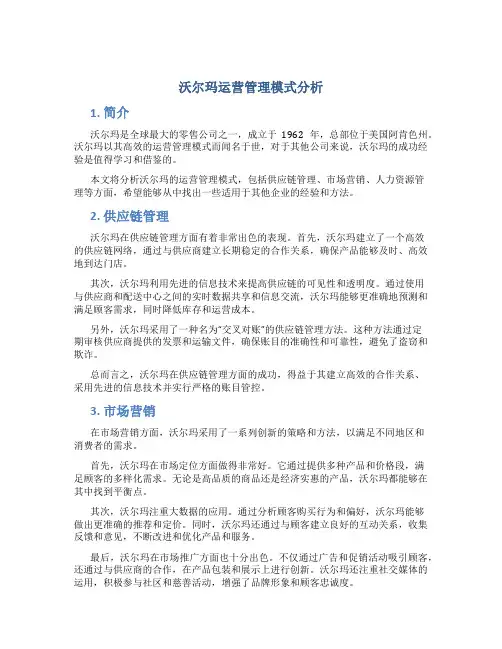
沃尔玛运营管理模式分析1. 简介沃尔玛是全球最大的零售公司之一,成立于1962年,总部位于美国阿肯色州。
沃尔玛以其高效的运营管理模式而闻名于世,对于其他公司来说,沃尔玛的成功经验是值得学习和借鉴的。
本文将分析沃尔玛的运营管理模式,包括供应链管理、市场营销、人力资源管理等方面,希望能够从中找出一些适用于其他企业的经验和方法。
2. 供应链管理沃尔玛在供应链管理方面有着非常出色的表现。
首先,沃尔玛建立了一个高效的供应链网络,通过与供应商建立长期稳定的合作关系,确保产品能够及时、高效地到达门店。
其次,沃尔玛利用先进的信息技术来提高供应链的可见性和透明度。
通过使用与供应商和配送中心之间的实时数据共享和信息交流,沃尔玛能够更准确地预测和满足顾客需求,同时降低库存和运营成本。
另外,沃尔玛采用了一种名为“交叉对账”的供应链管理方法。
这种方法通过定期审核供应商提供的发票和运输文件,确保账目的准确性和可靠性,避免了盗窃和欺诈。
总而言之,沃尔玛在供应链管理方面的成功,得益于其建立高效的合作关系、采用先进的信息技术并实行严格的账目管控。
3. 市场营销在市场营销方面,沃尔玛采用了一系列创新的策略和方法,以满足不同地区和消费者的需求。
首先,沃尔玛在市场定位方面做得非常好。
它通过提供多种产品和价格段,满足顾客的多样化需求。
无论是高品质的商品还是经济实惠的产品,沃尔玛都能够在其中找到平衡点。
其次,沃尔玛注重大数据的应用。
通过分析顾客购买行为和偏好,沃尔玛能够做出更准确的推荐和定价。
同时,沃尔玛还通过与顾客建立良好的互动关系,收集反馈和意见,不断改进和优化产品和服务。
最后,沃尔玛在市场推广方面也十分出色。
不仅通过广告和促销活动吸引顾客,还通过与供应商的合作,在产品包装和展示上进行创新。
沃尔玛还注重社交媒体的运用,积极参与社区和慈善活动,增强了品牌形象和顾客忠诚度。
4. 人力资源管理沃尔玛非常重视人力资源管理。
它认识到员工是组织的重要资产和竞争力,通过一系列的措施来吸引和留住优秀的员工。
作为全球最大的零售机构,进入中国几年来,沃尔玛似乎一直没有扑向它的核心猎物,而是悄悄地迂回于中国的海岸线上,它在熟悉环境和等待中国加入世贸组织.现在,它的时机已渐成熟,这只猛虎发起了进攻.留心的人士会注意到,去年沃尔玛在中国公司新增的店铺数几乎是过去5年所开店数的总和。
我们有必要了解沃尔玛.天天低价的背后沃尔玛的“女裤理论”是对“薄利多销"策略的最好解释:女裤的进价8美元,售价12美元,每条毛利4美元,一天卖10条,毛利为40美元。
如果售价降到10美元,每条毛利2美元,但一天能卖30条,则毛利为60美元。
那么如何做到“天天低价、薄利多销"呢?规模效应沃尔玛要求,供应商的报价必须是给其他商家的最低价,否则免谈。
在此基础上,沃尔玛以进货量巨大、帮助供应商进入世界市场、现金结算等三个理由,要求供应商降价25%。
巨大的规模和雄厚的资金实力使沃尔玛在谈判桌上取得了绝对的优势。
巨大的规模也使沃尔玛的各项费用和成本,在极大程度上被分摊。
分析:进货量巨大、现金结算、帮助供应商进入世界市场都表现出沃尔玛以购买者身份的强大的议价能力。
正所谓“财大气粗”,巨大的规模和雄厚的资金实力使沃尔玛在谈判桌上拥有绝对的优势.也给予给沃尔玛带来重要竞争优势的积极因素和独特能力。
在固定成本一定的情况下,生产量越大,单位成本也就越低。
巨大的规模分摊了沃尔玛的各项成本和费用,使其单位成本较低,从而为其“天天平价”提供了后盾。
这就是所谓的规模经济。
控制成本首先是厉行节约。
在沃尔玛中国总部,大家看到的是狭窄的过道和没有任何装修、素面朝天的办公大厅.在大厅内,随处可见“打17909,长话可省钱”的提示;而沃尔玛国际公司总经理约翰·门泽尔和他的下属们至今还挤在一起办公,他的那间办公室小得可怜。
其次对商品优胜劣汰。
每家店都要根据不同的地区和人文环境,根据顾客需求的变化,选择销售不同的产品。
这项工作的目的在于让货架上的商品永远都是适销的商品。